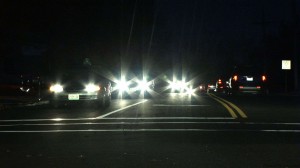
Even with the longer days of spring, driving at night is still challenging.
When you are behind the wheel of a car, your eyes are constantly on the move – looking at vehicles ahead and to the side, reading traffic signs, checking your rear view mirror, and shifting your gaze inside and outside your vehicle in order to check the speedometer, look at your global navigation system, or change a radio station.
During darkness these tasks can become even more difficult for some drivers. According to a nationwide survey 32% of the drivers say they have difficulty seeing all or most of the time while driving in the dark.
Low light levels cause the pupil to dilate, which can accentuate existing focusing problems and result in blurred vision. Wearing the best distance correction will minimize this vision problem. At Westside Optometry we also recommend a non-glare coating to eliminate reflections from annoying headlights.
Dry eyes will effect your vision when driving at night also. If the tear layer is uneven, thick or thin, the quality of vision is negatively impacted. I compare this phenomena to the windshield and wipers. Every blink is like the windshield wiper across the windshield, in the case of the eye, the eyelid wipes across the cornea. If the windshield is dry, the wiper makes it smeary. You can resolve this by squirting water on the windshield and wiping again. If the eye is dry, vision gets smeary and sometimes there are not any tears to clear it up. I recommend applying a drop of artificial tear solution before starting to drive at night.
When you do not see well you have to get closer or drive slower, and if you do not account for that need, you are at risk of causing accidents.